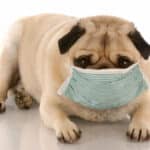
Home » Dander in the Dog World: How Allergic Fanciers Stay Active and Involved

For those immersed in the world of purebred dogs, whether as breeders, exhibitors, or judges, dog allergies can feel like both an irony and a professional obstacle. But having an allergy to dogs doesn’t always mean you have to step away from the sport. With smart management strategies and a deeper understanding of allergen behavior, it’s possible to remain active in the fancy while protecting your health.
It’s a common misconception that dog hair causes allergic reactions. The main offenders are proteins found in canine dander (shed skin), saliva, and urine, especially the proteins Can f 1 and Can f 2. These microscopic particles can linger in grooming areas, float in the air at indoor venues, and cover clothing. Long after a dog has left the ring, the allergens often remain.
Can f 1 and Can f 2 are produced in a dog’s salivary glands, and when a dog licks you, you’re getting a direct application of those allergens, often on sensitive skin, which can lead to localized hives, itching, or redness.
Once a dog licks its hair, or you, and that saliva dries, the proteins can flake off with the dander and become airborne. This is how allergen particles enter the respiratory system, triggering sneezing, congestion, itchy eyes, and even asthma symptoms.
It is prudent to remember that a kiss from a dog deposits a high, undiluted dose of allergenic proteins directly on the skin or clothing.
No dog is truly hypoallergenic. Breeds like the Chinese Crested, Maltese, or Toy Poodle may produce less dander or shed less, but they still secrete allergens. The key lies in managing exposure rather than expecting complete avoidance.
Absolutely, and many do. Some shift to breeds with lower dander levels, others become hyper-vigilant about grooming and air quality. For those with severe symptoms, allergists may suggest immunotherapy (allergy shots) tailored to dog-specific allergens, which can reduce or even eliminate reactions over time.
Allergies also intersect with responsible breeding. Just as breeders screen for cardiac issues, deafness, or patella luxation, understanding allergic reactivity, especially in multi-dog homes, can inform decisions about placement and co-ownership.
Living with dog allergies in the purebred dog world is a balancing act, but not a dealbreaker. Through diligence and adaptation, allergy sufferers can continue to thrive in the ring, whelp healthy litters, and mentor newcomers to the sport. The fancy is full of dedicated dog people who manage allergies with the same care they devote to preserving their breeds.
